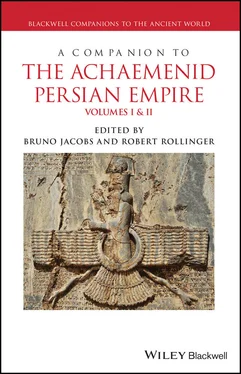Turning to some of the Greek literary sources, Xenophon's Anabasis is replete with geographical and topographic information, including the names of rivers crossed and places visited, but when describing, for example, Cyrus the Younger's passage from Cilicia to Thapsacus on the Euphrates, it scarcely offers any description of the country traversed (Xenophon, Anab . 1.4.11). Upon reaching “Arabia,” i.e. northern Mesopotamia (Donner 1986), more description is given. According to Xenophon, “In this region the ground was entirely a plain, level as the sea. It was covered with wormwood, and whatever other kinds of shrub or reed grew on it, were all odoriferous as perfumes. But there were no trees. There were wild animals, however, of various kinds; the most numerous were wild asses [onagers, Equus hemionus ]; there were also many ostriches, as well as bustards and antelopes” ( Anab . 1.5.1–2). Further south, as they approached Babylonia proper, “there was neither grass, nor any sort of tree, but the whole country was completely bare. The inhabitants, who quarried and fashioned millstones near the river [Euphrates], took them to Babylon, and sold them, and lived upon corn which they bought with the money” ( Anab . 1.5.5). This extreme barrenness is a perfectly accurate description for the time of year in which Cyrus' passage into Babylonia occurred. This has been dated to the very end of August (Watson and Ainsworth 1883: p. 260), which, with respect to the ancient Mesopotamian agricultural calendar, was after the annual harvest in July/August (Potts 1997: Table III.1). Some scholars have been puzzled by the absence of any reference to pastoral nomads and their herds in this description (e.g. Donner 1986), but from the general floral, faunal, environmental, and agricultural point of view, the description accords well with the semi‐arid nature of the steppic environment in this region during the late summer. In the fourteenth/fifteenth centuries, Turcoman nomads, such as the Aq‐qoyunlu, wintered in precisely this area – the steppe between Mosul on the Tigris and Raqqah and Bireçik on the Euphrates, north as far as Diyarbakır – but summered further north over an area extending from the east of Erzurum to the west of Erzincan, and almost as far north as the Black Sea (Woods 1999: Map 2). It is likely, therefore, that when Cyrus the Younger passed through, any pastoral nomads that might have frequented the region in winter had long since moved north to more temperate areas in Anatolia.
Later Greek sources compiled in the wake of Alexander's conquest provide a snapshot of environments found in the different satrapies of the Achaemenid Empire, naming rivers, mountain ranges, and other notable physical features as well as resources. The lost but heavily cited Geographika of Eratosthenes (Roller 2010), the later compendium of Strabo (Biffi 2002), and the histories of Alexander's campaigns (especially Arrian's Anabasis ) are invaluable sources of material on the landscapes of the late Achaemenid Empire. Even some of the most arid regions, like Gedrosia, produced economically (and medicinally) important resources. The flora of Gedrosia was described in considerable detail by Theophrastus (Theophrastus, Hist. Plant . 4.4.12–13; cf. Arrian, Anab . 6.22.4–8; Strabo, Geog . 15.2.3; Pliny, Nat. Hist . 12.33) and included, in the interior, a myrrh‐like aromatic ( bdellium ), triangular spurge ( Euphorbium antiquorum ), spikenard (sweet rush or ginger grass, Cymbopogon schoenanthus ), asafoetida ( Scorodosma foetidum ), oleander ( Nerium odorum ), and the date palm ( Phoenix dactylifera ) as well as mangrove ( Avicennia marina ) along the coast (Eggermont 1975: pp. 120–125; cf. Bretzl 1903). Many of these species were found in Aria, Arachosia, and Parapamisadae as well (Eggermont 1975: p. 123). Such accounts, while valuable, obviously present only the smallest fraction of the economically valuable flora, let alone the complete flora of these areas. There were many more species of great utility that went unmentioned, as a glance at the literature on the economic botany of, for example, eastern Iran clearly shows (Aitchison 1890). To mention just one wood that was highly prized for woodworking, Pakistani rosewood ( Dalbergia sissoo ), known widely as sissoo throughout the region, went unmentioned, although it was common throughout the Indo‐Iranian borderlands (Tengberg and Potts 1999).
Finally, archeological and in particular archeobotanical and paleoenvironmental studies at individual sites, along with regional surveys, have contributed to our knowledge of the climate and environment of the Achaemenid Empire. Studies around Gordion, in the ancient satrapy of Phrygia, for example, point to the existence of extensive non‐deciduous forests, containing pine ( Pinus sylvestris ), cedar ( Cedrus libani ), and yew ( Taxus baccata ), around the site about 2500 years ago (Erinç 1978: p. 97). Deforestation of these forests only began later, accelerating during the Roman period (Brice 1978).
It is clear from analyses of cores taken from Lakes Zeribar and Mirabad in northwestern Iran that there are few signs of climatic fluctuation in the region after about 3500 BCE (van Zeist 1967: pp. 310–311; Bottema 1986: p. 259; Jones 2013). Moreover, those indications of climatic shifts that do appear at Lake Mirabad all postdate the Achaemenid period (Griffiths et al. 2001: p. 761).
However, all across the Achaemenid Empire human intervention and modification of the landscape also must have played a role. This would have included the alteration of ecosystems through agricultural intensification, including olive cultivation in Fars (Jones et al. 2015; Djamali et al. 2016) and the expansion of irrigation systems involving the building of dams, qanats, and canals. There is a widespread if often unacknowledged belief that agricultural intensification was actively pursued by the Achaemenids, e.g. in the Deh Luran region, which lay astride the Royal Road between Susa and Babylon (Wright and Neely 2010: Fig. 6.6), but water management features are notoriously difficult to date, particularly when local masonry styles are not easily attributed to a particular period and commemorative or foundation inscriptions are absent (Boucharlat 2001: p. 178). Thus, the attribution of hydraulic features, attested archeologically, to the Achaemenid period is difficult. Moreover, even when hydraulic works mentioned in cuneiform or literary sources, or discovered in excavation, can be dated to the Achaemenid period, it is often unclear whether they resulted from centrally mandated imperial or locally driven investment, or indeed from a combination of the two. Evidence of local investment spurred by central governmental incentives can be found in Polybius' well‐known discussion of qanats in Media. According to Polybius ( History 10.28), “in this tract of country there is no water ( anhydria ) appearing on the surface, though there are many subterranean channels ( hyponomoi ) which have well‐shafts ( phreatiai ) sunk to them, at spots in the desert unknown to persons unacquainted with the district. A true account of these channels has been preserved among the natives to the effect that, during the Persian ascendancy, they granted the enjoyment of the profits to the inhabitants of some of the waterless districts for five generations, on the condition of their bringing fresh water in; and that, there being many large streams flowing down Mount Taurus [Alburz], these people at infinite toil and expense constructed these underground channels through a long tract of country in such a way that the very people who now use the water are ignorant of the sources from which the channels are originally supplied.”
Читать дальше












